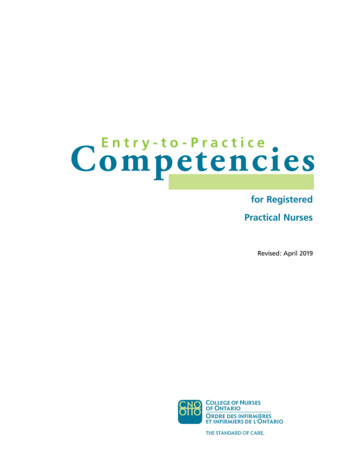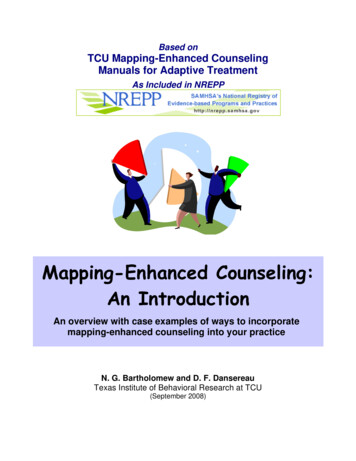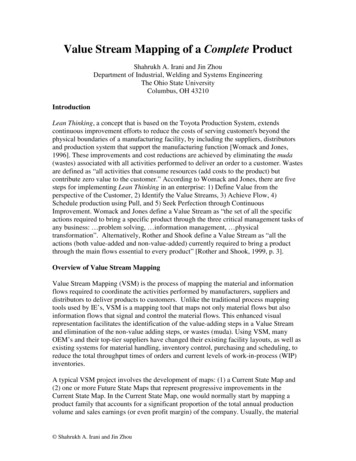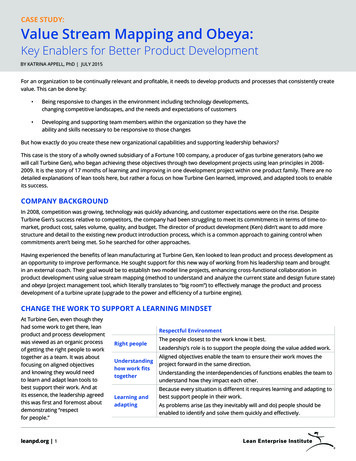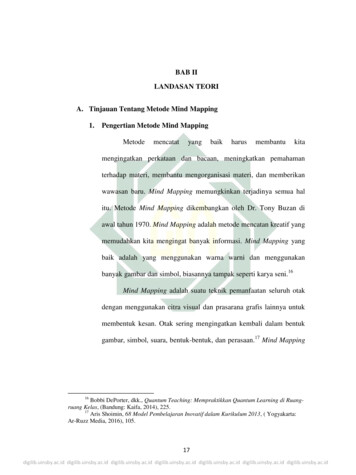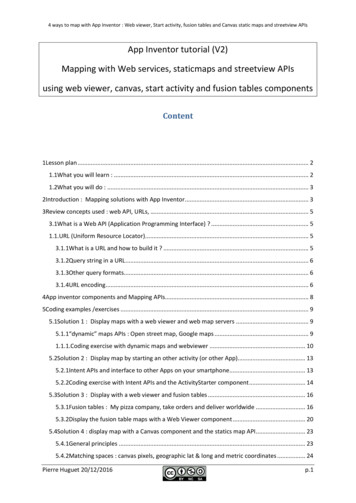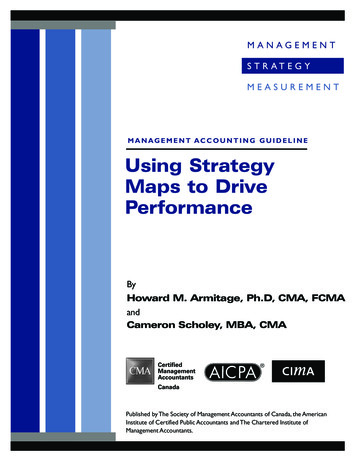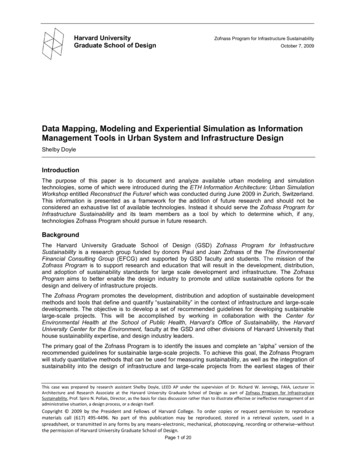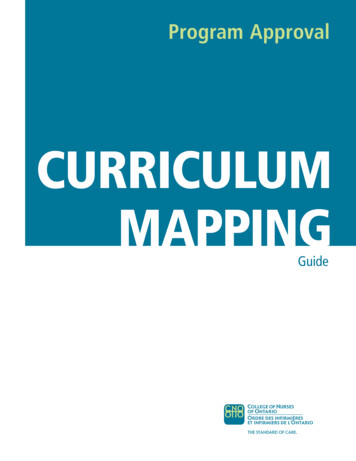
Transcription
Program ApprovalCURRICULUMMAPPINGGuide
Table of contentsIntroduction to curriculum mapping3When is curriculum mapping required?4Entry-to-practice competencies and foundational practice standards4Completing the curriculum mapping tool6Demographic data6Entry-to-practice competency sources of evidence6Entry-to-practice competency descriptors6Foundational practice standards9Curriculum mapping tool submission11Referencing supporting documents11Submitting documents - file structure11Legend12Online portal12Scoring the curriculum mapping tool13How each ETP competency is evaluated and rated13How each foundational practice standard is evaluated and rated15How the overall curriculum mapping tool is evaluated16Frequently asked questions17Appendix A: ETP competencies for each nurse class or category18Appendix B: Glossary19Program Approval Curriculum Mapping Guide College of Nurses of Ontario, 2019.Program approval documents are made available pursuant to a licensing agreement with College of Nurses of Ontario.Distributing program approval documents commercially, for-profit, or for any purpose other than their limited intended purpose is prohibited.College of Nurses of Ontario101 Davenport Rd.Toronto ON M5R 3P1www.cno.orgCollege of Nurses of OntarioProgram Approval Curriculum Mapping Information Guide 2
Introduction to curriculum mappingThis guide provides step-by-step instructions on how to complete a curriculum assessment usingthe College of Nurses of Ontario (CNO) curriculum mapping tool.Curriculum mapping is foundational to all entry-level nursing programs. It is one of theindicators used by CNO to evaluate and approve entry-level nursing education programs.Curriculum mapping is a mandatory indicator focused on the regulatory mandate of publicsafety, and integrating and teaching entry-to-practice (ETP) competencies.During a curriculum review, schools assess their curricula and provide evidence of the teachingand learning experiences required to prepare graduates to be competent and safe practicingnurses. Curriculum mapping provides a systematic approach for schools to document theircurriculum against foundational practice standards and ETP competencies for each program.A curriculum review is to be completed for all entry-level nursing programs offered [NursePractitioner (NP), Baccalaureate Nursing (RN), and Practical Nursing (RPN)]. CNO willprovide the schools with the following documents required to complete the curriculum review:CNO curriculum mapping tool (ETP competencies and foundational practice standards)CNO ETP competenciesEntry-to-practice competency interpretationsFoundational practice standards interpretations Entry-to-practice competency interpretations are provided for each class or category of nurse.Interpretations of the foundational practice standards are also provided. The interpretations weredeveloped by CNO staff and are supported by CNO practice documents. They are designed topromote consistency and standardize the competencies and standards. Schools are encouraged torefer to these interpretations when reviewing their program’s curriculum.College of Nurses of OntarioProgram Approval Curriculum Mapping Information Guide 3
When is curriculum mapping required?Curriculum mapping is required for entry-level nursing education programs under the followingtwo conditions:1. During the comprehensive review which happens every seven yearsA program will be notified in advance of their requirement to complete a curriculum mappingtool.Each entry-level nursing education program needs to complete one curriculum map. Forexample, if a school offers a Direct-Entry Full program and a Pre-Health Education EntrySpecified program, the school must complete a curriculum map for each of these programs.For schools participating in the Primary Health Care Nurse Practitioner program consortium,one curriculum map is required, as the curriculum is common across all schools.If gaps in the curriculum are identified during the review, a program may be requested toresubmit a complete or partial curriculum mapping tool before the next program approvalreview. 2. Forany new entry level nursing program being developedAny new program will require CNO Council approval before its implementation.Schools are to notify CNO of a new entry-level nursing program and are to complete thecurriculum mapping tool nine to 12 months before the program start date. Entry-to-practice competencies and foundational practice standardsEntry-to-practice competenciesEach class or category of nurse has a unique set of ETP competencies. These competenciesoutline the expectations (knowledge, skill, ability and judgment) nurses in Ontario must haveupon entry and ongoing registration with the College. The ETP competencies for each class orcategory have been organized into domains of practice or roles (Table 1). See Appendix A for thelinks to the ETP competencies for each class or category of nurse.Table 1: Domains of practice and roles for the ETP profiles for each nurse class or categoryRegistered PracticalNurse — ETP domainsof practiceRegistered Nurse —ETP rolesNurse Practitioner —ETP domains of practiceProfessional practiceClinicianClient careLegal practiceCommunicatorQuality improvement andresearchEthical practiceCollaboratorLeadershipFoundations of practiceAdvocateEducationCollaborative orCollege of Nurses of OntarioProgram Approval Curriculum Mapping Information Guide 4
Foundational practice standardsThe foundational practice standards identified below, were determined through the analysis ofCollege data from practice inquiries, complaints and mandatory reports over the past five years:Therapeutic Nurse-Client Relationships, Revised 2006Professional Standards, Revised 2002MedicationDocumentation, Revised 2008Confidentiality and Privacy — Personal Health Information Consistent “themes” of high risk practices with potential for the greatest impact on client safetyemerged from the data analysis. Table 2 lists the themes for each foundational practice standard.Table 2: Themes for each of the five foundational practice standardsFoundationalPractice StandardsThemesTherapeutic Nurse-ClientRelationship, Revised2006Students understand the adverse impact on client safety andquality of care when professional boundaries in the nurse-clientrelationship become blurred or crossed.Professional Standards,Revised 2002MedicationStudents understand that there are significant client safety andquality of care risks if the client does not have a full understanding/comprehension of informed consent.Schools support students to become reflective practitioners byimplementing and facilitating learning activities consistent withCNO’s Quality Assurance (QA) Program. Students engage insetting, achieving and evaluating learning goals. This shouldinclude integration of the CNO's QA documents.Students understand their accountabilities in preventing andreducing the likelihood of medication errors.Students understand that nurses and/or other colleagues who divertdrugs pose significant threats to client safety. (RN and PNs only –this is addressed in the NP curriculum.)Documentation, RevisedStudents understand that accurate, timely and complete nursing2008documentation decreases the potential for miscommunication anderrors. This is a critical factor for client safety.Confidentiality andStudents understand that inappropriate access to client informationPrivacy — Personal Health may adversely affect client safety and quality of care. It can alsoInformationundermine the client’s relationship with providers.College of Nurses of OntarioProgram Approval Curriculum Mapping Information Guide 5
Completing the curriculum mapping toolDemographic dataSchool nameProgram namePerson(s) completing the templateDate submittedDo not fill out any sections that state “for CNO use only” Entry-to-practice competency sources of evidenceEntry-to-practice competencies are listed on the left side of the curriculum mapping tool. Thesource of evidence to support each competency (syllabus, course outline, clinical evaluation form,etc.) should be documented in the same row as the competency, under the appropriate columnheadings.Entry-to-practice competency descriptorsIn the ‘descriptor column’, provide explicit information and direction as to where the source ofevidence can be found. There must be a minimum of one descriptor. Table 3 lists some examplesof sources of evidence and descriptors.Table 3: Examples of sources of evidence and descriptorsSource of EvidenceDescriptorCourse syllabusChapter/module titlesParagraph or page numbersCourse outcomesLearning outcomesForm sectionsCourse outlineIntegrated practicum manualStudent handbookClinical evaluation formThere are three types of evidence required: theoretical, application and evaluative. Theseevidence categories enable the school to demonstrate certain components clearly:1. teaching and learning opportunities that address theory concepts2. key educational experiences that enable students to demonstrate application of acquiredknowledge and skills, and3. evaluation processes that determine the student’s understanding and integration of knowledge.Sources of evidence examples include, but are not limited to:Theoretical – article, course syllabus, book chapter, CNO practice standardApplication – assignment or seminar discussion on assigned readingsEvaluation – scoring rubric for assignment Schools are required to provide a minimum of one and a maximum of three sourcesof evidence for each category (theoretical, application and evaluative) for each ETPcompetency. Figures 1-3 show examples of mapped competencies.In some instances, the same source of evidence can be used across more than one category. Asource of evidence can also be used to support more than one ETP competency. Note that agreater number of sources of evidence does not lead to a higher rating. It is not necessary tosubmit three sources of evidence when one source substantiates the ETP competency.College of Nurses of OntarioProgram Approval Curriculum Mapping Information Guide 6
It is important to submit the most relevant source of evidence that best substantiates the ETPcompetency. Use sources that:provide direct evidence of teaching and evaluating students’ attainment of all ETPcompetenciesprovide evidence indicating that components of the ETPs are fully integratedprovide enough support to indicate acquisition of the competency in the course content orevaluative processsupport the ETP competency interpretation. Figure 1: Mapped NP ETP competency showing source of evidence and descriptor columnsCollege of Nurses of OntarioProgram Approval Curriculum Mapping Information Guide 7
Figure 2: Mapped RN ETP Competency Showing Source of Evidence andDescriptor ColumnsFigure 3: Mapped RPN ETP Competency Showing Source of Evidence andDescriptor ColumnsCollege of Nurses of OntarioProgram Approval Curriculum Mapping Information Guide 8
Foundational practice standardsThe foundational practice standards are located on the second tab of the curriculum mappingtool (Figure 4). Only one source of evidence and descriptor(s) for each foundational practicestandard theme is required per evidence category (theoretical, application and evaluative)See Figure 5.The source of evidence must directly address the theme(s) identified for each of the fivefoundational practice standards. There is overlap between the foundational themes and the ETPcompetencies. However, in the ETP competencies, the actual theme is sometimes embeddedwithin the larger competency. For example, “develops a therapeutic relationship with clients.”There are many components of the therapeutic relationship that a school may choose to mapfor this ETP competency. It may, or may not, be the identified foundational theme of, “impacton client safety and quality of care when professional boundaries in the nurse client relationshipbecome blurred or crossed.”If a school has provided sources of evidence (including the relevant CNO practice standard)that substantiate the foundational theme within their ETP competencies, then furthersources of evidence are not required for mapping of the foundational theme. Simply list theETP competency number on the foundational map, or copy the information from the ETPcompetency.Figure 4: Foundational practice standards mapCollege of Nurses of OntarioProgram Approval Curriculum Mapping Information Guide 9
Figure 5: Example of a mapped foundational practice standard themeCollege of Nurses of OntarioProgram Approval Curriculum Mapping Information Guide 10
Curriculum mapping tool submissionReferencing supporting documentsSchools are required to submit documents that are cited in the curriculum mapping tool. Forexample, if a schools cites “AHAD 1 Syllabus” as a source of evidence, it must submit thesyllabus and any corresponding descriptors with the completed map.Schools must ensure the sources of evidence and descriptors are provided in a consistent manner.For example, if the same course meets more than one competency, the course title must beentered in the same manner for each ETP competency it is being used to support. Titles ofsupporting documents submitted with the completed curriculum mapping tool must also matchwhat is entered on the map.When referencing an article, exam, quiz or book chapters as sources of evidence, schools are notrequired to submit the actual article, exam/quiz questions or book chapters.Submitting documents – file structureTitles of supporting documents need to match what is entered on the mapping tool. Useconsistent nomenclature throughout the mapping tool.Here is an example of a file structure:Indicator 4 (curriculum mapping) Pathophysiology course Syllabus Modules Assignments Evaluation rubrics Pharmacotherapeutics courseSyllabus Modules Assignments Supporting documentsConsultation note grading formReflective journalClinical evaluation formLearning Plan formInvestigative modules College of Nurses of OntarioProgram Approval Curriculum Mapping Information Guide 11
LegendSchools can also submit a legend with their curriculum mapping tool. Table 4 shows an exampleof a legend.Table 4: Example of a legendCOLCourse outlineCOCourse outcomeLearning outcomePathophysiologyIntegrated practicumLOPathoIPOnline portalSchools submit their curriculum mapping files electronically through a secure online portal.Instructions and access are provided to schools during orientation sessions.College of Nurses of OntarioProgram Approval Curriculum Mapping Information Guide 12
Scoring the curriculum mapping toolThe curriculum mapping indicator is a mandatory indicator and must be met (receive a scoreof two) for program approval. The curriculum mapping tool has two components that contributeto the total curriculum mapping score: The ETP competencies and the foundational practicestandards. The total curriculum mapping score is converted to an indicator score that is includedas part of the overall program approval score. This section describes:how the ETP competencies are evaluated and ratedhow the foundational practice standards are evaluated and ratedhow the ETP competencies and foundational practice standard ratings contribute to theoverall curriculum mapping tool rating and score How each ETP competency is evaluated and ratedEach ETP competency is evaluated and rated for curriculum integration using sources ofevidence from the following categoriesTheoreticalApplicationEvaluation The competency is rated as either:MetPartially met; orNot met Definitions for these ratings are listed in Table 5.College of Nurses of OntarioProgram Approval Curriculum Mapping Information Guide 13
Table 5: Ratings and definitions for ETP y is explicitly demonstrated through supportingevidence and the assessor is not required to make any inferences.Partially metNot metAt least one source of evidence for each category (theory,application and evaluation) is identified and demonstrates explicitintegration into the curriculum. Sources of evidence demonstrateclear alignment with the competency definition.Competency is partially demonstrated through supporting evidenceand the assessor is required to make some inferences.At least one source of evidence for each category (theory,application and evaluation) is identified and demonstratesintegration into the curriculum. Sources of evidence do notdemonstrate clear and consistent alignment with the competencydefinition. The assessor is required to make some inferences.Competency is not demonstrated through the supporting evidenceand the assessor is required to make major inferences.Less than one source of evidence for each category (theory,application and evaluation) is identified for each competency.Sources of evidence do not demonstrate clear and consistentalignment with the competency definition.College of Nurses of OntarioProgram Approval Curriculum Mapping Information Guide 14
How each foundational practice standard is evaluated and ratedEach foundational practice standard is evaluated and rated as met or not met. There is nopartially met option in the rating of these five standards. Definitions for these ratings are listedin Table 6.Table 6: Ratings and definitions for foundational practice standardsRatingDefinition/CriteriaMetThe practice standard theme is explicitly demonstrated through thesupporting evidence and the assessor is not required to make anyinferences.Not metSources of evidence for each category (theory, application andevaluation) are identified and demonstrate explicit integration intothe curriculum. Sources of evidence demonstrate clear alignmentwith the foundational practice standard.The practice standard theme is not demonstrated through thesupporting evidence and the assessor is required to make majorinferences.Sources of evidence for each category (theory, application andevaluation) are identified for each competency. Sources of evidencedo not demonstrate clear and consistent alignment with thefoundational practice standard.College of Nurses of OntarioProgram Approval Curriculum Mapping Information Guide 15
How the overall curriculum mapping is evaluatedThe ratings for the ETP competencies and the foundational practice standards contribute to theoverall curriculum mapping score. For a rating of met (score 2), the curriculum mapping tooltemplate must meet the following three criteria:There are no unmet ETP competencies (all ETP competencies must be rated met or partiallymet per Table 5); and75% or more of the ETP competencies within each role/domain must be rated met; and100% of the foundational practice standards must be rated met. See Figure 6. Table 7 outlines the rating definitions for overall scoring of the curriculum mapping tool.Table 7: Definitions for overall curriculum mapping tool ratings and scoresRatingScoringDefinition/CriteriaMet2Not met0A program is considered to have met curriculum expectations whenall three criteria are achieved.A program is considered to have not met curriculum expectationswhen any one or a combination of the criteria are not achieved.Figure 6: Curriculum mapping tool criteria contributing to a program approval indicatorscoreAll ETPCompetencies fullyor partially met 75% ETPCompetencieswithin each role/domain fully metProgram approvalcurriculum indicatorscore100% FoundationalPractice StandardsmetCollege of Nurses of OntarioProgram Approval Curriculum Mapping Information Guide 16
Frequently asked questionsHow many descriptors can be included on the curriculum mapping tool?There is no maximum for the number of descriptors. There must be a minimum of onedescriptor. Descriptor(s) must provide explicit information and direction as to where the evidencecan be found in the curriculum. For example, Chapter 1, Section 1.3, pp. 12-15.Can I use the same source of evidence for more than one ETP competency?Yes. A source of evidence can be used to support more than one competency. To illustrate fullintegration of the ETP into the curriculum, schools are encouraged to use multiple sources ofevidence and descriptors, and not rely on a select few.Can I use the same source of evidence for more than one category (theoretical,application, evaluation)?Yes. In some instances the same source of evidence can be used across more than one category.What kind of documents should I submit to support the curriculum mappingtool?Schools are required to submit documents that are cited in the curriculum mapping tool. Titlesof supporting documents submitted must match what is entered in the completed curriculummapping tool. Schools are not required to submit exams, quiz questions, articles or bookchapters.College of Nurses of OntarioProgram Approval Curriculum Mapping Information Guide 17
Appendix A:ETP competencies for each nurse class/categoryRegistered Nurse:Entry-to-Practice Competencies for Registered NursesRegistered Practical Nurse:Entry-to-Practice Competencies for Ontario Registered Practical NursesNurse Practitioner:Entry-to-Practice Competencies for Nurse PractitionersCollege of Nurses of OntarioProgram Approval Curriculum Mapping Information Guide 18
Appendix B: GlossaryThis glossary defines the words found in the curriculum mapping tool, the ETP competenciesand foundational standards interpretation documents.Accountability/Accountable: The obligation to answer the professional, ethical and legalresponsibilities of one’s activities and duties.Activities of Daily Living (ADLs): This term is used in health care to refer to people's dailyself-care activities. These activities can include getting dressed, preparing meals and attending topersonal hygiene.Acuity: A level of severity of an illness. An acuity level is based on the type and number ofnursing interventions required in a 24-hour period to provide safe, competent and ethical nursingcare for a client.Advocate: To actively support a right or cause; to support others when speaking for themselvesor when speaking on behalf of those who cannot speak for themselves.Approval: This term designates an education program has met the prescribed standards set outin the College of Nurses of Ontario’s (CNO) program approval process. Program approval is amandatory process based on the entry-to-practice competencies for a class or category of a nurse(RN, PN, or NP).Boundary: A professional line that separates a nurse’s therapeutic behaviour from any behaviourthat could reduce the benefit of nursing care to clients, families or communities.Canadian Council for Practical Nurse Regulators (CCPNR): The federation of provincialorganizations whose provincial and territorial members are identified in legislation responsible forthe safety of the public through the regulation of licensed or registered practical nurses.Canadian Council of Registered Nurse Regulators (CCRNR): Promotes excellence inprofessional nursing regulation. An organization made up of representatives from Canada’s 12provincial (territorial) bodies that regulate the practice of registered nurses. CCRNR serves as anational forum and voice regarding interprovincial, national and global regulatory matters fornursing regulation.Circle of care: The circumstances where health information custodians rely on an individual'simplied consent when collecting, using, disclosing or handling personal health information forthe purpose of providing direct health care.Client: Individuals, families, groups or entire communities across the lifespan who requirenursing expertise. In some clinical settings, the client may be referred to as a patient or a resident.Client-centred care: A foundational philosophy that clients are the experts in their lives.Clients play an active role in the management, maintenance and restoration of their health. Theirdecisions and beliefs are respected and incorporated in the plan of care.Code of conduct: A set of rules that outlines the social norms and behavioural expectations ofan individual, group or organization.College of Nurses of OntarioProgram Approval Curriculum Mapping Information Guide 19
Collaborate/Collaboration: To work together with one or more members of the health careteam, including the client. Each person makes a unique contribution to achieving a commongoal, and contributes from within the limits of their scope of practice.Community/unique community: An organized group of people bound together by social,ethnic, cultural or occupational ties, or by geographic location.Competence: The ability of a nurse to combine the professional attributes required to performin a given role, situation or practice setting. Professional attributes include, but are not limited toknowledge, skill, judgment, values and beliefs.Comprehensive review: One component of the program approval framework used to approveentry-level nursing education programs. For the comprehensive review, all program approvalindicators are reviewed every seven years, unless annual review results are unsatisfactory, and theprogram’s approval score is calculated.Consult: To seek information or advice. For example, from a person or a book.Consultation: The act or an instance of consulting.Controlled acts: Activities considered potentially harmful if performed by unqualified people.Members of regulated health care professions are authorized to perform specific controlled actsappropriate to their profession’s scope of practice.Critical inquiry: The process of gathering and evaluating information, ideas, evidence andassumptions from multiple perspectives to produce well-reasoned analysis and understanding.This leads to new ideas, applications and questions.Critical thinking: Reasoning in which an individual analyzes the use of language, formulatesproblems, clarifies and explains assumptions, weighs evidence, evaluates conclusions,distinguishes between pros and cons and seeks to justify those facts and values that result incredible beliefs and actions. Critical thinking is performed by all nurses at a level consistent withtheir educational preparation and scope of practice.Cultural competence: An ability to interact effectively with people of different cultures andsocio-economic backgrounds. This is important in the context of health care as nurses interactwith clients from different ethno-cultural backgrounds. Cultural competence requires that nursesbe aware of their own cultural worldview, recognize their attitudes about cultural differences,have an appreciation for different cultural practices and develop cross-cultural skills. Developingcultural competence results in an ability to understand, communicate with and effectivelyinteract with clients across cultures.Cultural safety: To affirm, respect and foster the cultural expression of clients. This requiresnurses to reflect critically on issues of health equity, gender inequality, racism and discrimination,and practise in a way that affirms the culture of clients.Culture: The beliefs, social norms and traits of a racial, religious or social group.College of Nurses of OntarioProgram Approval Curriculum Mapping Information Guide 20
Curriculum: The planned process for achieving a nursing education program’s intendedoutcomes. For purposes of program approval, nursing curricula includes theoretical foundations,learning activities to foster theory application by students and evaluation of student learning.Curriculum mapping: A process for collecting and documenting curriculum relatedinformation against specific criteria or standards. This process ensures an alignment between thestandards of nursing practice, entry-to-practice competencies and the educational content beingtaught. It also identifies and addresses academic gaps, redundancies and misalignments betweencourses and entry-to-practice competencies.Curriculum mapping tool: Each entry-level nursing program is required to map itscurriculum to ETP competencies, for both preliminary approval (new programs) and thecomprehensive review process (established programs), using the curriculum mapping tool.Programs use the tool to provide evidence that the entry-to-practice competencies, required toprepare graduates to be competent and safe practicing nurses for their category and/or class ofnursing, are embedded in the teaching and learning experiences.Delegate/delegation: A formal process that transfers authority to perform a controlled act.A regulated health care professional who has the legislative authority and the competence toperform a procedure within one of the controlled acts can delegate it to others. This processincludes educating, determining competence and establishing a process for assessing ongoingcompetence. A written record of the process must be kept by the nurse or employer.Determinants of health: A complex interaction among social and economic factors, thephysical environment and individual behaviour that determine health. The factors do not existin isolation from each other; combined, they influence health status. The key determinants areincome and social status, social support networks, education, employment or working conditions,social environments, physical environments, personal health practices and coping skills, healthychild development, biology and genetic endowment, health services, gender and culture.Direct-Entry Full Program (DEF): An educational program with established admissioncriteria granting direct entry to graduates from an Ontario Secondary School, or to maturestudents. Students adhere to a structured curriculum designed to support them in meeting theeducational requirements for CNO’s entry-to-practice competencies for either the RPN or RNGeneral Class category. The curriculum is set by the educational provider. The duration of studyis typically two years for the Practical Nursing program and four years for a baccalaureate degree.Upon completion of the program, the successf
the College of Nurses of Ontario (CNO) curriculum mapping tool. Curriculum mapping is foundational to all entry-level nursing programs. It is one of the indicators used by CNO to evaluate and approve entry-level nursing education programs. Curriculum mapping is a . mandatory indicator . focused on the regulatory mandate of public
